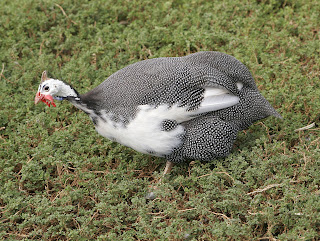Guinea Fowl | The guinea fowl is a large wild bird that is natively found inhabiting a variety of habitats across the African continent. Today, the guinea fowl
has been introduced to various countries around the world as it is
farmed by humans. The guinea fowl is a ground-nesting bird and spends
much of its time scratching around on the ground in search for something
to eat. The guinea fowl often has long, dark coloured feathers and a bald neck and head which makes the guinea fowl a very distinctive bird.
The guinea fowl is a fairly resilient and highly adaptable bird and
the guinea fowl is therefore found naturally in range of habitats. Wild
guinea fowl can be found inhabiting jungles, forests, shrublands,
grasslands and even areas of desert, depending on the abundance of food. In their native Africa, guinea fowl have been used as domestic animals for hundreds of years as the large size of the guinea fowl means that just one bird can provide a great deal of food. Today, guinea fowl are farmed around the world for their meat, eggs and feathers.
The guinea fowl is an omnivorous bird and therefore has a diet that consists of both plants and other animals. Guinea fowl primarily feed on worms and insects on
the ground, along with seeds, berries and small mammals and reptiles.
The guinea fowl has numerous predators wherever it happens to be. Mammals including
wildcats, dogs, wolves and humans and large reptiles such as snakes and
crocodiles. are the most common predators of the guinea fowl.
The female guinea fowl
builds a nest out of twigs and leaves on the ground, often somewhere
where it is more sheltered. The female guinea fowl lays between 8 and 15
small eggs which hatch after an incubation period of around a month.
The guinea fowl chicks, known as keets, remain with their mother until they are big enough to fend for themselves.





No comments:
Post a Comment